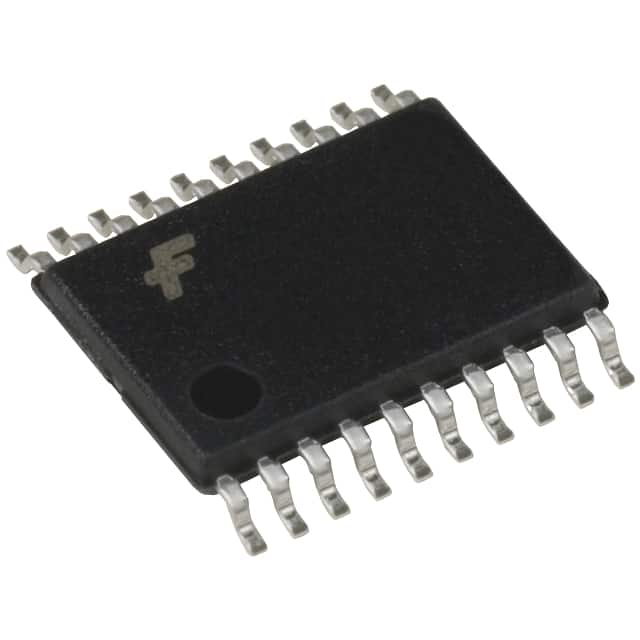74LCXZ2245MTCX
Basic Information Overview
- Category: Integrated Circuit (IC)
- Use: Level Shifter and Bus Transceiver
- Characteristics: Low Voltage, Bidirectional, Octal, Non-Inverting
- Package: TSSOP (Thin Shrink Small Outline Package)
- Essence: Logic Level Translation and Signal Conditioning
- Packaging/Quantity: Tape and Reel, 2500 pieces per reel
Specifications
- Supply Voltage Range: 1.65V to 3.6V
- Input Voltage Range: 0V to VCC
- Output Voltage Range: 0V to VCC
- Maximum Operating Frequency: 100MHz
- Number of Channels: 8
- Input/Output Type: Tri-State
- Propagation Delay Time: 2.5ns (Max)
- Output Current: ±24mA
- ESD Protection: Human Body Model > 2000V
Detailed Pin Configuration
The 74LCXZ2245MTCX has a total of 24 pins. The pin configuration is as follows:
+-------------------+
OE1 |1 24| VCC
A1 |2 23| OE2
B1 |3 22| GND
A2 |4 21| B2
B2 |5 20| A3
A3 |6 19| B3
B3 |7 74LCXZ2245M 18| A4
A4 |8 TCX 17| B4
B4 |9 16| A5
A5 |10 15| B5
B5 |11 14| A6
A6 |12 13| B6
+-------------------+
Functional Features
- Bidirectional level shifting between two voltage domains.
- Non-inverting translation of logic signals.
- Tri-state outputs for bus-oriented applications.
- Low voltage operation suitable for battery-powered devices.
- High-speed operation up to 100MHz.
Advantages and Disadvantages
Advantages: - Wide supply voltage range allows compatibility with various systems. - Tri-state outputs enable easy interfacing with multiple devices on a bus. - Fast propagation delay time ensures efficient signal transmission.
Disadvantages: - Limited output current may not be suitable for driving heavy loads. - ESD protection may not be sufficient for certain harsh environments.
Working Principles
The 74LCXZ2245MTCX is designed to shift logic levels between two voltage domains. It utilizes a combination of MOSFETs and CMOS technology to achieve bidirectional level translation. The inputs are compatible with both low-voltage and high-voltage systems, allowing seamless communication between them. The tri-state outputs enable multiple devices to share a common bus without interference.
Detailed Application Field Plans
The 74LCXZ2245MTCX is commonly used in various applications, including: 1. Communication systems: Facilitating level shifting between different voltage domains in data transmission circuits. 2. Microcontrollers and embedded systems: Enabling interfacing between low-voltage microcontrollers and higher-voltage peripheral devices. 3. Industrial automation: Providing signal conditioning and level translation in control systems. 4. Consumer electronics: Supporting communication between different subsystems within devices like smartphones and tablets.
Detailed and Complete Alternative Models
- SN74LVC245A: Similar octal non-inverting bus transceiver with 3.3V to 5V voltage compatibility.
- MC74LVX245: Octal non-inverting bus transceiver with 2.0V to 3.6V voltage compatibility.
- 74HCT245: Octal bus transceiver with TTL-level compatibility and wider supply voltage range.
(Note: These alternative models are provided for reference and may have different specifications and pin configurations. It is recommended to consult the respective datasheets for detailed information.)
In conclusion, the 74LCXZ2245MTCX is a versatile level shifter and bus transceiver IC that enables bidirectional logic level translation between different voltage domains. Its low-voltage operation, tri-state outputs, and high-speed performance make it suitable for various applications in communication systems, microcontrollers, industrial automation, and consumer electronics.
قم بإدراج 10 أسئلة وإجابات شائعة تتعلق بتطبيق 74LCXZ2245MTCX في الحلول التقنية
Sure! Here are 10 common questions and answers related to the application of 74LCXZ2245MTCX in technical solutions:
Q: What is the 74LCXZ2245MTCX? A: The 74LCXZ2245MTCX is a bidirectional octal bus transceiver with 3-state outputs, designed for low-voltage applications.
Q: What is the voltage range supported by the 74LCXZ2245MTCX? A: The 74LCXZ2245MTCX supports a voltage range of 1.65V to 3.6V.
Q: How many channels does the 74LCXZ2245MTCX have? A: The 74LCXZ2245MTCX has 8 bidirectional channels.
Q: What is the maximum data transfer rate of the 74LCXZ2245MTCX? A: The 74LCXZ2245MTCX can operate at a maximum data transfer rate of 400Mbps.
Q: Can the 74LCXZ2245MTCX be used in both input and output applications? A: Yes, the 74LCXZ2245MTCX can be used as both an input and output buffer.
Q: Does the 74LCXZ2245MTCX support 3-state outputs? A: Yes, the 74LCXZ2245MTCX supports 3-state outputs, allowing multiple devices to share a common bus.
Q: What is the power supply voltage required for the 74LCXZ2245MTCX? A: The 74LCXZ2245MTCX requires a power supply voltage of 2.3V to 3.6V.
Q: Can the 74LCXZ2245MTCX be used in mixed-voltage systems? A: Yes, the 74LCXZ2245MTCX is designed to be compatible with mixed-voltage systems.
Q: What is the package type of the 74LCXZ2245MTCX? A: The 74LCXZ2245MTCX comes in a TSSOP-24 package.
Q: Are there any special considerations when using the 74LCXZ2245MTCX in high-speed applications? A: Yes, it is important to ensure proper signal integrity and minimize transmission line effects when using the 74LCXZ2245MTCX in high-speed applications.
Please note that these answers are general and may vary depending on specific application requirements.


